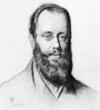- Lear, Edward
-
died Jan. 29, 1888, San Remo, ItalyEnglish painter and comic poet.From age 15 he earned his living by drawing. Employed to illustrate the earl of Derby's private menagerie in the 1830s, he later produced Book of Nonsense (1846) for the earl's grandchildren. His other works include Nonsense Songs, Stories, Botany and Alphabets (1871), containing "The Owl and the Pussy-Cat," and Laughable Lyrics (1877). He is best known for popularizing the limerick. He also published volumes of bird and animal drawings and seven illustrated travel books. Epileptic and depressive, he lived mainly abroad after 1837.
 Edward Lear, drawing by William Holman Hunt, 1857; in the Walker Art Gallery, LiverpoolBy courtesy of the Walker Art Gallery, Liverpool
Edward Lear, drawing by William Holman Hunt, 1857; in the Walker Art Gallery, LiverpoolBy courtesy of the Walker Art Gallery, Liverpool* * *
▪ English painter and writerborn May 12, 1812, Highgate, near London, Englanddied January 29, 1888, San Remo, ItalyEnglish landscape painter who is more widely known as the writer of an original kind of nonsense verse and as the popularizer of the limerick. His true genius is apparent in his nonsense poems, which portray a world of fantastic creatures in nonsense words, often suggesting a deep underlying sense of melancholy. Their quality is matched, especially in the limericks, by that of his engaging pen-and-ink drawings.The youngest of 21 children, Lear was brought up by his eldest sister, Ann, and from age 15 earned his living by drawing. He subsequently worked for the British Museum, made drawings of birds for the ornithologist John Gould (Gould, John), and, during 1832–37, made illustrations of the earl of Derby's private menagerie at Knowsley, Lancashire. Lear had a natural affinity for children, and it was for the earl's grandchildren that he produced A Book of Nonsense (1846, enlarged 1861). In 1835 he decided to become a landscape painter.Lear suffered all his life from epilepsy and melancholia. After 1837 he lived mainly abroad. Though naturally timid, he was a constant and intrepid traveler, exploring Italy, Greece, Albania, Palestine, Syria, Egypt, and, later, India and Ceylon [now Sri Lanka]. An indefatigable worker, he produced innumerable pen and watercolour sketches of great topographical accuracy. He worked these up into the carefully finished watercolours and large oil paintings that were his financial mainstay. During his nomadic life he lived, among other places, at Rome, Corfu, and, finally, with his celebrated cat, Foss, at San Remo.Lear published three volumes of bird and animal drawings, seven illustrated travel books (notably Journals of a Landscape Painter in Albania, &c., 1851), and four books of nonsense—A Book of Nonsense mentioned earlier, Nonsense Songs, Stories, Botany, and Alphabets (1871), More Nonsense, Pictures, Rhymes, Botany, etc. (1872), and Laughable Lyrics (1877). A posthumous collection, Queery Leary Nonsense (1911), was edited by Constance Braham Strachey.Additional ReadingBiographies of the artist include Angus Davidson, Edward Lear: Landscape Painter and Nonsense Poet (1812–1888) (1938, reissued 1968);Vivien Noakes, The Painter, Edward Lear (1991); and Peter Levi, Edward Lear (1995). Lear's own writings are available in Edward Lear in Southern Italy: Journals of a Landscape Painter in Southern Calabria and the Kingdom of Naples (1964; originally published as Journals of a Landscape Painter in Southern Calabria, 1852); and Vivian Noakes (ed.), Edward Lear: Selected Letters (1988). Important studies of Lear's art include Philip Hofer, Edward Lear as a Landscape Draughtsman (1967); and Vivien Noakes, Edward Lear, 1812–1888 (1985). Elizabeth Sewall, The Field of Nonsense (1952), discusses the work of both Lear and his contemporary Lewis Carroll. Ann C. Colley, Edward Lear and the Critics (1993), which includes bibliographic references, gives a critical perspective on the writer and painter.* * *
Universalium. 2010.
